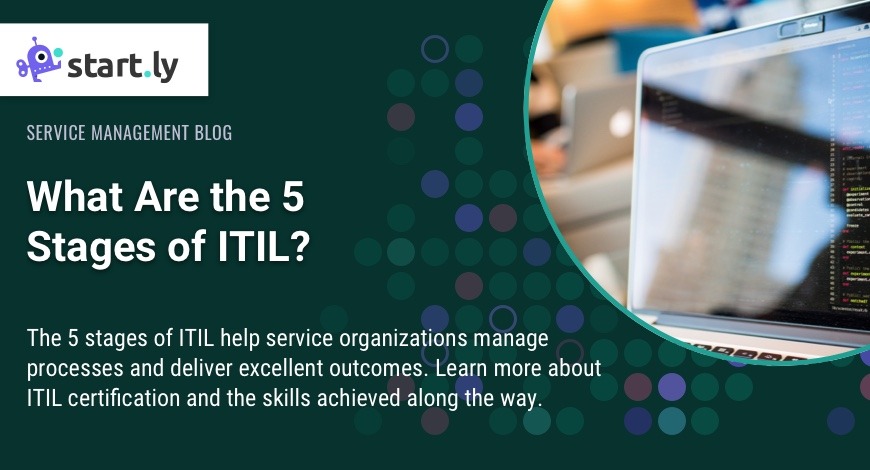There are 5 stages of the Information Technology Infrastructure Library (ITIL) service lifecycle: strategy, design, transition, operation, and service improvement. These ITIL service management processes drive success for many teams in IT service management and delivery. Whether delivering break-fixes or deploying a companywide upgrade, the following ITIL processes list can help you get oriented. We’ll also cover the stages of progress through the ITIL course and how experts grow through ITIL certification.
What Are the Service Management Processes of ITIL?
- Strategy: Service management starts with deciding the service which needs to be delivered and other goals.
- Design: How do the current infrastructure, products, and talent on the team intersect with the needs of the project?
- Transition: This is the process of leaving room for the unexpected and planning to adapt to change without losing control of the end result.
- Operation: It’s important to monitor the day-to-day and seek out the pain points that become problems in the long run.
- Service improvement: Take action based on found issues and feedback, as well as new innovations that enter the market.
Along the ITIL certification pathway, IT professionals develop their skills in one or more of these processes.
5 Stages of ITIL Certification
There are 5 stages of ITIL certification, but only the first and the last are the same for everyone. Professionals start with ITIL Foundation.
1. ITIL Foundation
This course is for anyone who needs to understand IT and digital service delivery. Lots of companies today offer technology-enabled products and services. This course introduces service management terminology and end-to-end processes to learners.
2. ITIL Modules
In the next phase of certification, people complete different modules supporting their journey toward top-tier ITIL certification.
- In the Create, Deliver, and Support module, an ITIL specialist becomes certified in core competencies of IT service delivery. This includes how to both identify and implement efficiencies, as well as managing IT teams.
- In the Drive Stakeholder Value module, an ITIL specialist becomes certified in optimizing and managing the customer experience. This includes special training for managing key stakeholders and shaping customer demand.
- In the High-velocity IT module, an ITIL specialist becomes certified in increasing the speed and quality of service delivery, especially through Lean, Agile, or DevOps approaches.
- In the Direct, Plan, and Improve module, an ITIL specialist becomes certified in encouraging a culture of continual improvement and nurturing confident decision-making. Passing the graduation exam from this module means a graduate is also certified as an ITIL Strategist.
- In the Digital and IT Strategy module, an ITIL specialist becomes certified in crafting a digital vision, leading cross-organizational strategy, and responding to digital disruption. Passing the graduation exam from this module means a graduate is also certified as an ITIL Leader.
IT professionals will have to complete at least two modules to progress to the next level of certification.
3. ITIL Expert Certification Streams
- ITIL Managing Professional (MP)
After completing 4 modules, Managing Professionals have practical knowledge of how to run a successful IT team and deliver IT-enabled services. - ITIL Strategic Leader (ITIL SL)
After completing 2 modules, Strategic Leaders have a clear understanding of how IT influences and directs business strategy.
4. ITIL Extension Modules
The ITIL extension modules are developed to help IT professionals meet the emerging needs of the cutting-edge. There are currently two modules in the curriculum:
- ITIL Specialist: Sustainability in Digital and IT
Those certified in this module understand how IT and digital services impact the environment, and how to impact it more positively. - ITIL Specialist: Acquiring & Managing Cloud Services
Those certified in this module have a practical understanding of cloud technology, cloud procurement, and how to analyze solutions from a vendor-neutral perspective.
5. ITIL Master
To be eligible for certification as an ITIL Master, a candidate must have five years of IT leadership or management experience, as well as having achieved an ITIL Expert certification. Each person speaks to their own professional experience and application of ITIL principles to demonstrate their preparedness to hold the certification.
What Are the Functions of ITIL? Track Each Through Startly
Along the trajectory of ITIL certification, professionals learn to master three main functions of ITIL: change management, incident management, and problem management.
- Change Management: Whether changes are planned for a long time or come up unexpectedly, a service organization has to be able to adapt. Startly has an integrated change management process that keeps you on track from planning to approvals, implementation, and even during an audit.
- Incident Management: When incidents arise, IT needs to respond quickly and with intention. Startly unifies multi-channel ticketing traffic in a single dashboard so every user sees the incident, history of service, and any response in progress.
- Problem Management: Some issues go beyond a single incident to become a chronic problem. In those cases, ITIL teaches experts how to identify and address the root cause. Startly integrates a knowledge base for self-serve support and community infosourcing.
Startly is an all-in-one software solution to enable IT Service Management. Explore our product and reach out with any questions!

